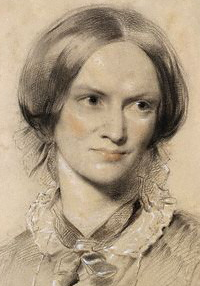
LIFE AS MYTH
![]()
JOURNAL
![]()
JOURNAL 2011
![]()
Life as Myth
Naming a life
![]()
SPRING 2011
Naming her life
![]()
LIFEWORKS
![]()
ATLAS
![]()

SPRING 2011
NAMING HER LIFE
Charlotte Brontë, chalk, George Richmond. circa 1850. National Portrait Gallery, London.
Responsibility to yourself means refusing to let others do your thinking, talking, and naming for you...it means that you do not treat your body as a commodity with which to purchase superficial intimacy or economic security; for our bodies to be treated as objects, our minds are in mortal danger. It means insisting that those to whom you give your friendship and love are able to respect your mind. It means being able to say, with Charlotte Bronte's Jane Eyre: "I have an inward treasure born with me, which can keep me alive if all the extraneous delights should be withheld or offered only at a price I cannot afford to give."
Adrienne Rich [1929-] poet, feminist, essayist
Charlotte Brontë wrote under two pen names: initially as Lord Charles Albert Florian Wellesley, later as Currer Bell. She is the only one of the Brontë sisters who received recognition for her work in her lifetime. Her best known novel is Jane Eyre which contains much autobiographical material. For example, she used her personal experience of boarding school at Cowan Bridge in her depiction of Lowood School, the boarding facility which Jane Eyre attends. Charlotte also models Helen Burns, a young girl who dies of consumption at Lowood, after her sisters.
After the deaths of Anne, Emily and Branwell, Charlotte centered her life around her father's care. Her portrayal of female passion and desire in her heroine Jane Eyre had made Charlotte and her novel subject to attack. By living life as the dutiful daughter of her parson father, she was able to know some measure of peace. Despite the cost of her notoriety, on occasion, her publisher managed to persuade her to visit London where she socialized with the city's literary elite.
She saw two more manuscripts published before her death: Shirley (1849) and Villette (1853). In June 1854, at the age of thirty-eight, Charlotte married Arthur Bell Nichols, the vicar of Haworth. She was in the early stages of pregnancy the following spring when she contracted tuberculosis and died. She is the only literary Brontë to receive significant recognition in her lifetime.
WORKS OF CHARLOTTE BRONTË
The Green Dwarf, A Tale of the Perfect Tense (1833)
Tales of Angria (1834)
Poems by Currer, Ellis, and Acton Bell (1846)
Jane Eyre (1847)
Shirley (1849)
Villette (1853)
The Professor (published posthumously 1857)
Emma (unfinished)

